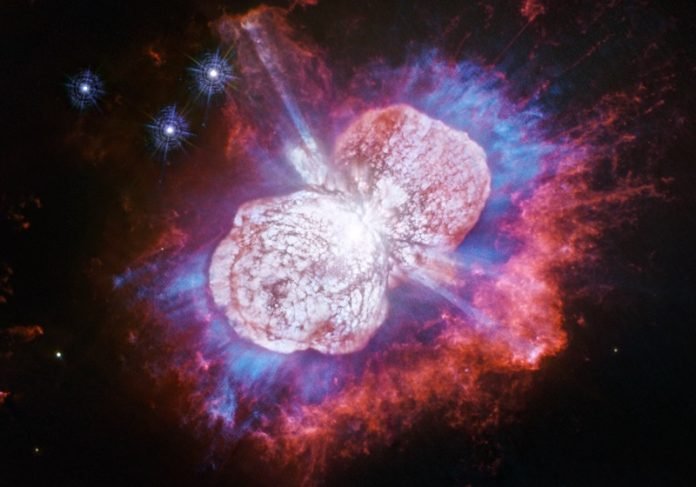
In 1840 an unassuming star in the Southern Hemisphere brightened suddenly.
What had been a 5th magnitude star became so bright by 1843 that it was the second brightest star in the sky.
The star, known as Eta Carinae, had been known to vary in brightness before, but this change was so sudden and so dramatic that it became known as the Great Eruption.
The strange thing about the event is that it appeared similar to a supernova, but the star was not destroyed.
After 1843 the star faded and has had small variations in brightness ever since. It’s currently a 4th magnitude star. So astronomers have long strived to determine what caused such a monumental, yet not cataclysmic, brightening.
We now known that Eta Carinae is not a single star, but a star system. I contains at least two stars.
The larger is about 100 solar masses and by far the brightest. The smaller is about 30 solar masses.
The two stars are at the center of a double-lobed nebula known as the Homunculus Nebula, which is the result on the 1841 eruption. The nebula contains about 40 solar masses of gas, which a tremendous amount to be cast off in a single event.
About 50 years ago a bright ring of X-ray emissions was found surrounding the Homunculus Nebula. It’s likely caused by the outer edge of the expanding nebula colliding with interstellar gas at high speed, triggering a shock wave.
Now a new study using data from NASA’s Chandra X-ray Observatory has found a second outer ring of X-ray emissions. The outer X-ray shell has a similar shape and orientation as the Homunculus Nebula, leading the team to suspect the two have a common origin.
Combining the Chandra with observations from XMM-Newton, the team found that X-ray emissions faded over time.
They compared this with a rough model of the eruption, estimating the speed and amount of gas needed to match observations. Based on this, the team thinks the Great Eruption was likely a two-stage event.
The first was an ejection of low-density gas at high speed, while the second was more dense gas and dust at lower speed, forming the nebula.
The study adds a layer of complexity to the mysterious eruption. While we still don’t understand what triggered the eruption, or why such a tremendous explosion failed to destroy Eta Carinae, we now know it wasn’t a single, sudden event. It will take more observations to understand why.
Follow us on Twitter for more articles about this topic.
Written by Brian Koberlein/ Universe Today.



